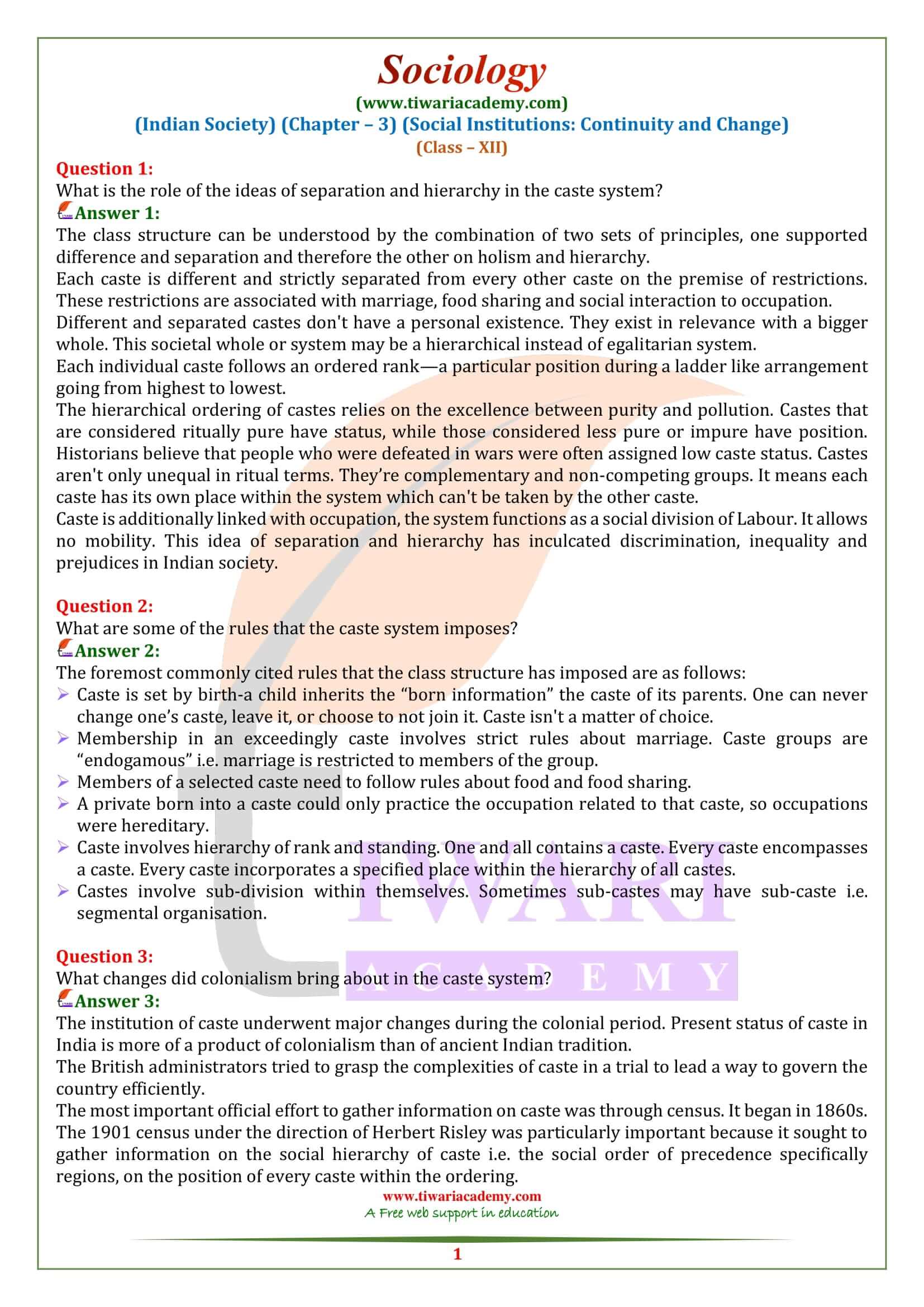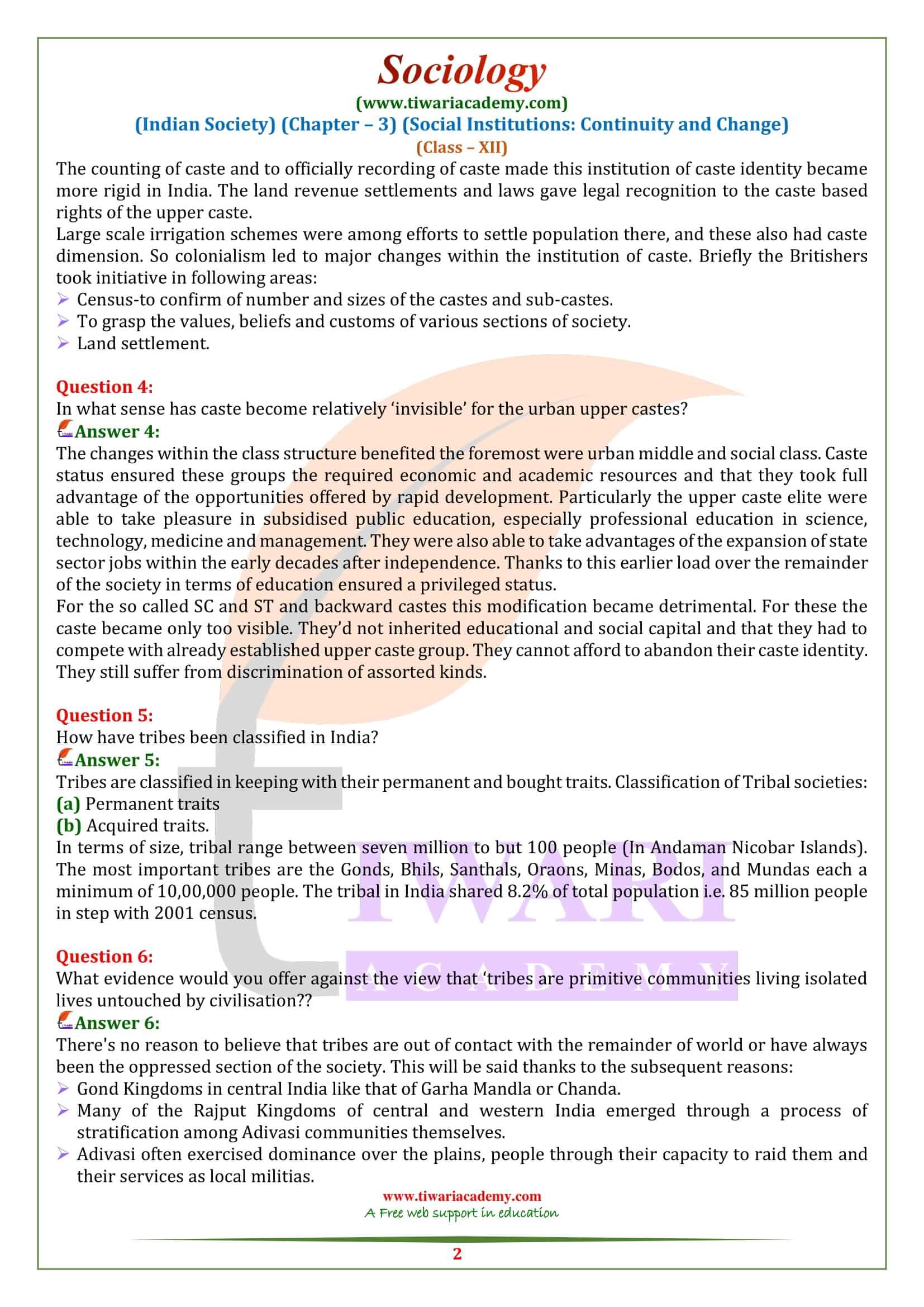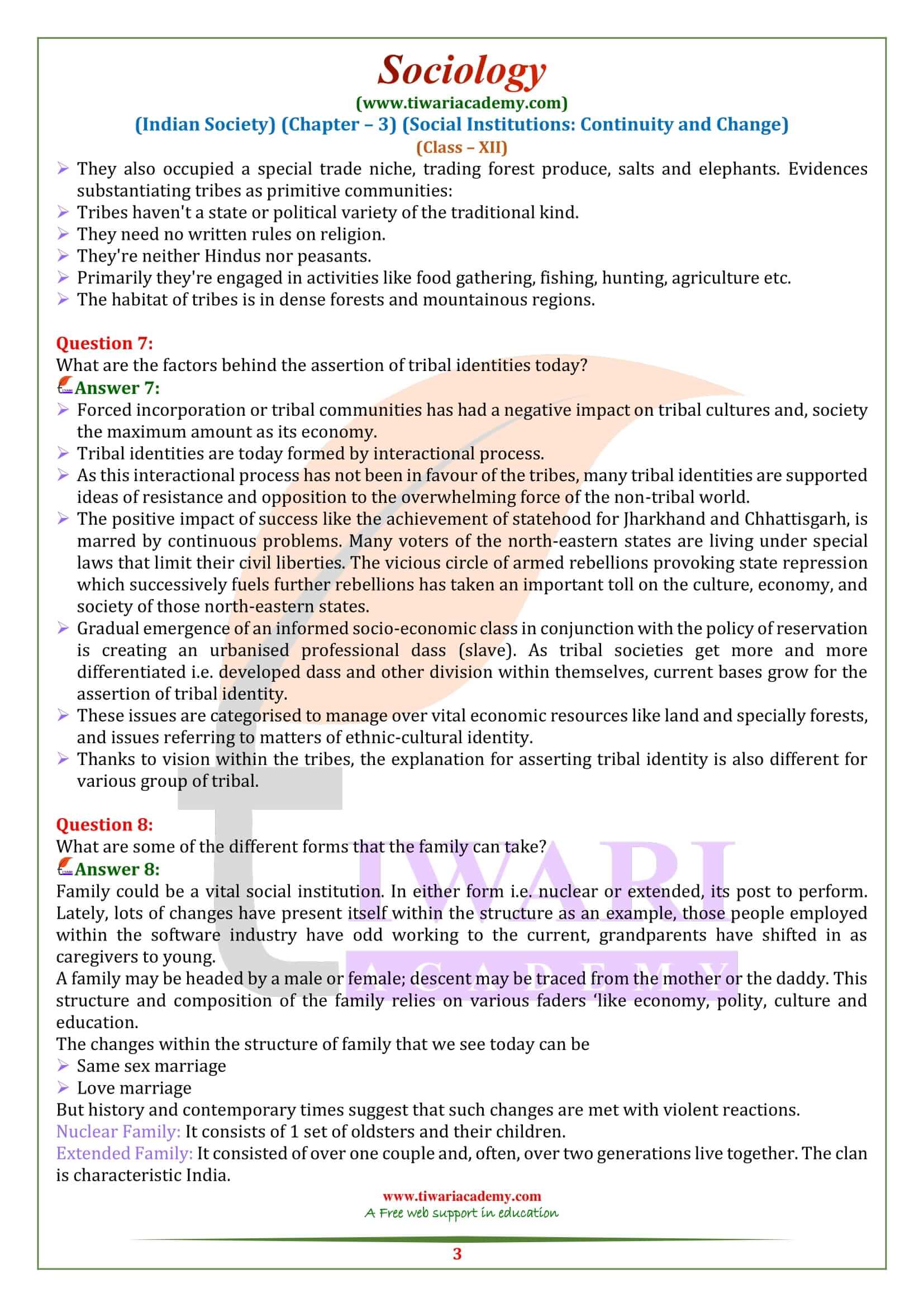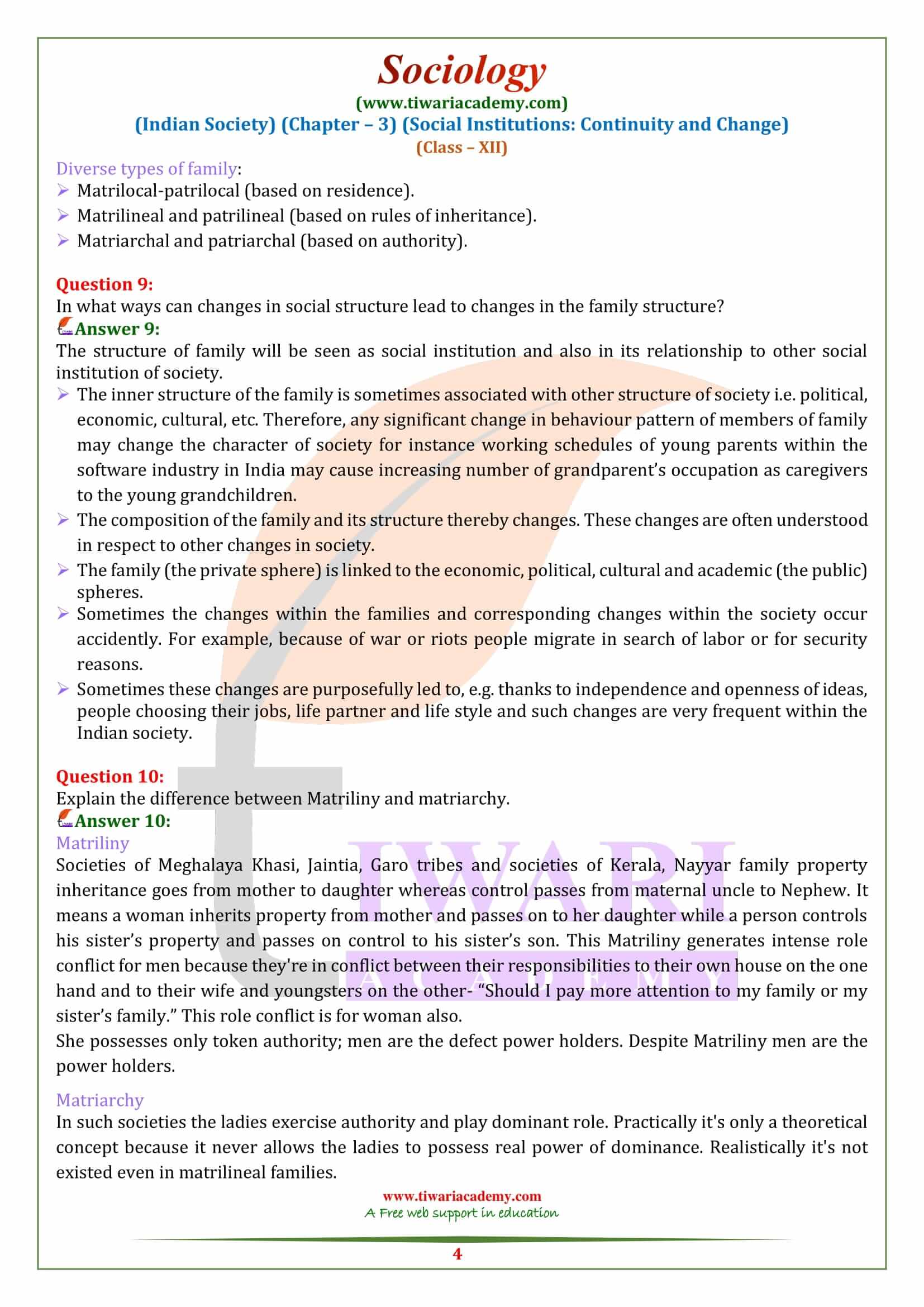NCERT Solutions for Class 12 Sociology Chapter 3 Social Institutions: Continuity and Change in English Medium updated for CBSE session 2025-26. All the question answers with MCQ of class 12 part 1 sociology Indian Society chapter 3 are given here with compete explanation.
Class 12 Sociology Chapter 3 Social Institutions Continuity and Change Question answers
What is the role of the ideas of separation and hierarchy in the caste system?
The class structure can be understood by the combination of two sets of principles, one supported difference and separation and therefore the other on holism and hierarchy. Each caste is different and strictly separated from every other caste on the premise of restrictions. These restrictions are associated with marriage, food sharing and social interaction to occupation.
Different and separated castes don’t have a personal existence. They exist in relevance with a bigger whole. This societal whole or system may be a hierarchical instead of egalitarian system. Each individual caste follows an ordered rank—a particular position during a ladder like arrangement going from highest to lowest.
The hierarchical ordering of castes relies on the excellence between purity and pollution. Castes that are considered ritually pure have status, while those considered less pure or impure have position. Historians believe that people who were defeated in wars were often assigned low caste status. Castes aren’t only unequal in ritual terms. They’re complementary and non-competing groups. It means each caste has its own place within the system which can’t be taken by the other caste.
Caste is additionally linked with occupation, the system functions as a social division of Labour. It allows no mobility. This idea of separation and hierarchy has inculcated discrimination, inequality and prejudices in Indian society.
What are some of the rules that the caste system imposes?
The foremost commonly cited rules that the class structure has imposed are as follows:
- Caste is set by birth-a child inherits the “born information” the caste of its parents. One can never change one’s caste, leave it, or choose to not join it. Caste isn’t a matter of choice.
- Membership in an exceedingly caste involves strict rules about marriage. Caste groups are “endogamous” i.e. marriage is restricted to members of the group.
- Members of a selected caste need to follow rules about food and food sharing.
- A private born into a caste could only practice the occupation related to that caste, so occupations were hereditary.
- Caste involves hierarchy of rank and standing. One and all contains a caste. Every caste encompasses a caste. Every caste incorporates a specified place within the hierarchy of all castes.
- Castes involve sub-division within themselves. Sometimes sub-castes may have sub-caste i.e. segmental organisation.
In what sense has caste become relatively ‘invisible’ for the urban upper castes?
The changes within the class structure benefited the foremost were urban middle and social class. Caste status ensured these groups the required economic and academic resources and that they took full advantage of the opportunities offered by rapid development. Particularly the upper caste elite were able to take pleasure in subsidised public education, especially professional education in science, technology, medicine and management. They were also able to take advantages of the expansion of state sector jobs within the early decades after independence. Thanks to this earlier load over the remainder of the society in terms of education ensured a privileged status.
For the so called SC and ST and backward castes this modification became detrimental. For these the caste became only too visible. They’d not inherited educational and social capital and that they had to compete with already established upper caste group. They cannot afford to abandon their caste identity. They still suffer from discrimination of assorted kinds.
What changes did colonialism bring about in the caste system?
The institution of caste underwent major changes during the colonial period. Present status of caste in India is more of a product of colonialism than of ancient Indian tradition. The British administrators tried to grasp the complexities of caste in a trial to lead a way to govern the country efficiently.
The most important official effort to gather information on caste was through census. It began in 1860s. The 1901 census under the direction of Herbert Risley was particularly important because it sought to gather information on the social hierarchy of caste i.e. the social order of precedence specifically regions, on the position of every caste within the ordering.
The counting of caste and to officially recording of caste made this institution of caste identity became more rigid in India. The land revenue settlements and laws gave legal recognition to the caste based rights of the upper caste.
Large scale irrigation schemes were among efforts to settle population there, and these also had caste dimension. So colonialism led to major changes within the institution of caste. Briefly the Britishers took initiative in following areas:
- Census-to confirm of number and sizes of the castes and sub-castes.
- To grasp the values, beliefs and customs of various sections of society.
- Land settlement.
How have tribes been classified in India?
Tribes are classified in keeping with their permanent and bought traits. Classification of Tribal societies: (a) Permanent traits
(b) Acquired traits.
In terms of size, tribal range between seven million to but 100 people (In Andaman Nicobar Islands). The most important tribes are the Gonds, Bhils, Santhals, Oraons, Minas, Bodos, and Mundas each a minimum of 10,00,000 people. The tribal in India shared 8.2% of total population i.e. 85 million people in step with 2001 census.
What evidence would you offer against the view that ‘tribes are primitive communities living isolated lives untouched by civilisation?
There’s no reason to believe that tribes are out of contact with the remainder of world or have always been the oppressed section of the society. This will be said thanks to the subsequent reasons:
- Gond Kingdoms in central India like that of Garha Mandla or Chanda.
- Many of the Rajput Kingdoms of central and western India emerged through a process of stratification among Adivasi communities themselves.
- Adivasi often exercised dominance over the plains, people through their capacity to raid them and their services as local militias.
- They also occupied a special trade niche, trading forest produce, salts and elephants. Evidences substantiating tribes as primitive communities:
- Tribes haven’t a state or political variety of the traditional kind.
- They need no written rules on religion.
- They’re neither Hindus nor peasants.
- Primarily they’re engaged in activities like food gathering, fishing, hunting, agriculture etc.
- The habitat of tribes is in dense forests and mountainous regions.
Explain the difference between Matriliny and matriarchy.
Matriliny
Societies of Meghalaya Khasi, Jaintia, Garo tribes and societies of Kerala, Nayyar family property inheritance goes from mother to daughter whereas control passes from maternal uncle to Nephew. It means a woman inherits property from mother and passes on to her daughter while a person controls his sister’s property and passes on control to his sister’s son. This Matriliny generates intense role conflict for men because they’re in conflict between their responsibilities to their own house on the one hand and to their wife and youngsters on the other- “Should I pay more attention to my family or my sister’s family.” This role conflict is for woman also.
She possesses only token authority; men are the defect power holders. Despite Matriliny men are the power holders.
Matriarchy
In such societies the ladies exercise authority and play dominant role. Practically it’s only a theoretical concept because it never allows the ladies to possess real power of dominance. Realistically it’s not existed even in matrilineal families.
What is the relevance of chapter 3 of Sociology in the overall context of Indian economic development and otherwise?
The steps taken for abolition untouchability and treating people of all caste equally has bonded the Indian society. The distinction between upper caste and lower caste has diminished in urban areas but this is still seen in parts of rural and under developed areas.
What are the important terms to learn in chapter 3 of sociology class 12?
Some of the important terms used in this chapter 3 of sociology are hierarchical system, endogamous marriage, Land settlement systems Sanskritisation and Verna.
What are the three important questions from chapter 3 of class 12th sociology?
There long answer type questions which are considered as important one, are given below:
- what are the rules that the caste system imposes?
- How have tribes being classified in India?
- In What ways changes in social structure lead to change in family structure?





